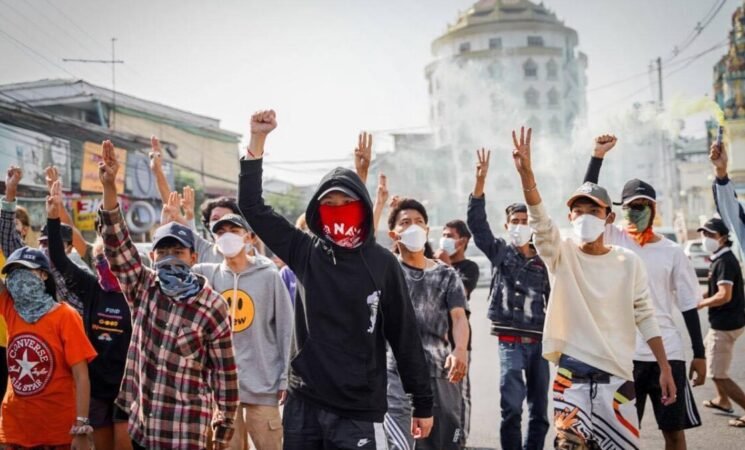11 September 2025, NIICE Commentary 11692
Mohit Singh Mehra
South Asia stands at a demographic crossroads, a large share of the population is young and of working age, giving the region a potential “demographic dividend” if economies can absorb and productively employ this section of the population. Yet in recent years, the region’s youth have repeatedly taken to the streets not only to demand political change but to demand work, fairness, and an end to nepotism. When the state fails to convert youth potential into jobs and dignity, frustration turns into protest. The waves that toppled or shook governments in Sri Lanka (2022), Bangladesh (July 2024), and Nepal (September 2025) serve as a warning of how quickly public anger can bring down leaders.
In Nepal, the September 2025 protests by Gen Z against the corrupt system were triggered by a ban on 26 social media platforms; it was anger that had been building for years. Years of seeing economic opportunity shrink, corruption scandals go unpunished, and politicians’ children flaunting luxury while many youth struggle. During the demonstrations, the #NepoKid also went viral, as young protesters mocked the children of politicians who were seen enjoying wealth and privilege while ordinary youth struggled without jobs or fair opportunities. The Indian Express reported, “We were exasperated by the daily news of corruption, from minor government offices to the highest levels of power. The taxes we paid were never used properly. Roads, health infrastructure, and schools were inadequate, yet the children of politicians lived in luxury.” Youth do not just want change in leadership; they want the system changed, so merit matters, and nepotism does not block their futures. The protest forced Prime Minister K.P. Sharma Oli to resign.
Bangladesh in July 2024 also saw major student protests over how government job quotas were being used. Young graduates argued that these quotas often benefited political families or people connected to the ruling party, rather than the most capable applicants. Before the movement, 44% of first and second-class jobs were merit-based, and the remaining 56% reserved for specific communities - 30% for freedom fighters' children and grandchildren, 10% for women, 10% for backward districts, 5% for ethnic minorities, and 1% for disabled people. Protesters from Bangladesh demand the reform of the quota system, but this has turned into chaos. The unrest was fueled by high unemployment among young people, who make up nearly a fifth of Bangladesh’s population of 170 million.
Sri Lanka’s 2022 protests are another similar case. The turmoil began with an economic breakdown, the crisis quickly moved from households to the public square, protestors camped in central Colombo, and by July 2022, Rajapaksa had fled the country and resigned, ending years of Rajapaksa family dominance. There was a major economic collapse that led to shortages of fuel and food, soaring inflation, and general hardship. Young people in particular felt that political leaders, including the Rajapaksa family with its multiple office-holders, had diverted opportunities for themselves, and the general public was suffering. Nepotism or benefits for those with connections rather than merit, and government neglect of basic services made things worse. Many youth felt that if the government cared, there would have been work and stability already.
Unlike Sri Lanka, Bangladesh, and Nepal, India has not yet seen large-scale youth protests that forced top leaders out of power. But this does not mean that the frustration is absent. Many young people in India struggle with unemployment and underemployment, and corruption in recruitment exams or public appointments has sparked anger in different states. Debates about nepotism, whether in politics, film, or business, often resurface, showing how sensitive the issue is for the younger generation. For instance, thousands in West Bengal lost teaching and non-teaching jobs after the Supreme Court struck down over 25,000 appointments due to irregularities and many of those affected have been protesting, demanding their jobs back and fair rules and another example, In August 2025, around 1,000 students and educators gathered at Ramlila Maidan in New Delhi to protest against alleged errors, unfair answer keys, delayed merit lists, and lack of clarity in the Staff Selection Commission (SSC) exam process. Still, youth unemployment and corruption remain central topics in India’s political debates and election campaigns. Given that Sri Lanka, Bangladesh, and Nepal are India’s immediate neighbours, their experience should be seen as a warning. If young people in India feel ignored for too long, and if their demands for fair employment and good governance are not met, protests of a larger scale could spread within India as well. The same is true for Pakistan, where a young population faces similar frustrations, and where corruption and lack of jobs remain burning issues.
What do these episodes show? First, that protests are not spontaneous; they are symptoms of deeper failures. Governments are not creating enough good jobs, education that doesn’t equip youth for those jobs, and political systems that tolerate or enable corruption and favouritism. Second, that youth are increasingly unwilling to wait. Social media amplifies what was always happening quietly; seeing obvious inequality and nepotism made the anger stronger.
Many young people in South Asia feel they have no choice but to leave their country and look for work abroad. They see that there are not enough good jobs at home, or that jobs often go to those with political or family connections. Because of this, migration has become both an escape and a sign of the failures at home. Today, South Asia has one of the largest diasporas in the world. The money these migrants send back is huge. In Nepal, remittances make up over a quarter of the country’s total income, and in India, they reached more than $118 billion in 2023–24, the highest in the world. These remittances help families pay for food, health care, and education, but they cannot replace the need for jobs at home. In fact, they highlight how governments have failed to give young people chances in their own countries. Unless these opportunities are created, migration will continue to drain talent from the region, and the so-called “demographic dividend” may slip away.
The region’s demographic dividend is not being realised. According to the World Bank, from 2000 to 2023, South Asia created only about 10 million jobs a year, which is just over half of what was required to absorb its growing working-age population. As a result, unemployment among the 15–24 age group has remained stubbornly high, with Nepal’s rate rising to 12.6 per cent in 2022–23, up from 11.4 per cent in 2017–18. The World Bank had warned in 2024 that South Asia was on the path ‘that Risks Squandering its Demographic Dividend of Growth’.
For South Asian nations to better utilize their young population, governments must first ensure that jobs are created in large numbers and that they are given out fairly. This means building transparent systems for recruitment so that youth feel they are rewarded for merit and not left behind by nepotism or corruption. Education and training also need to match the needs of today’s job market, from digital skills to vocational training linked with industry, so that young people are ready for employment at home instead of being forced to migrate. At the same time, governments should support small businesses and local industries by cutting red tapism and giving easier access to credit, since these sectors employ most people. Money sent home by migrants can also be turned into a long-term asset by creating schemes that channel part of it into productive investments such as infrastructure, start-ups, and community enterprises. Most importantly, youth must be given a real voice in policymaking through youth councils and participatory forums so they see themselves as partners in governance rather than outsiders. If South Asian leaders act on these fronts together, they can turn the current frustration into energy for growth and ensure that their demographic dividend becomes a true national advantage rather than a lost opportunity.
South Asia’s young people have huge potential. The challenge is political leaders stepping up, committing to fairness, accountability, and opportunity. If they do, the region could gain massively from its youth population. If they do not, the protests will keep coming up, and also be instability in the region.
Mohit Singh Mehra is a Master’s Student, Department of International Relations, South Asian University, India.
The views expressed here are the author's personal views.

